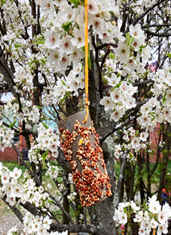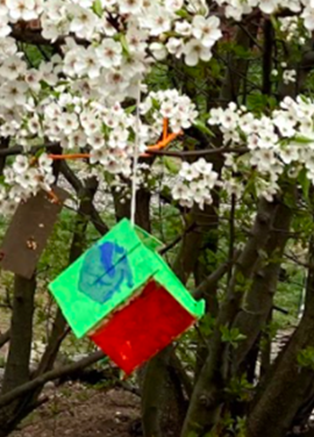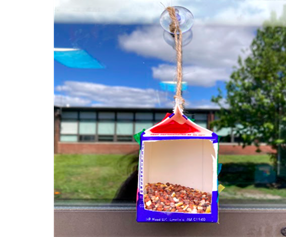Backyard Birding
Developed by Tara Mollo, PCM Play Intensive 2021
(FOCUS: PreK-Kindergarten, Science, Mathematics, STEM, Language, Creativity & Making, Design Thinking)
Birdwatching is a great way to study nature. Children love to observe and identify birds to learn more about them. This bird-watching activity can help children learn about birds, and increase their knowledge about the many types or species of birds native to Rhode Island.
Through this activity students will create ways to attract birds to their school yard or backyard to observe. Students will do this by creating colorful birdhouses, bird nests and making bird feeders.
New Vocabulary:
- Habitat: a place where animals live
- Natural: coming from nature, not made by humans
- Protect: to keep safe from harm
- Model: a three-dimensional representation or copy
- Data: facts and other information collected together to look at closely
- Record: to draw or write information
Materials
- Common Backyard Birds, by Doris Dumrauf
- Birdhouse (Dollar Tree has mini birdhouse)
- Stickers (to use to decorate bird house)
- Paint (assortment of bright and natural colors)
- Colored Pencils, crayons, markers, pencils
- Stapler or Hole Puncher
- Pipe Cleaners
- Small Suction Cup Hangers
- Bird Seed
- Peanut Butter/Sunbutter
- Small Containers (to put peanut butter/sunbutter and bird seed in)
- Popsicle Sticks (to use to spread peanut butter)
- Plates or trays one for each student
- Recycled Materials- paper towel tubes, newspaper, shredded paper, small school milk carton
- Tissue Paper
- Clay
- Natural Materials- leaves, long strands of grass, thin sticks and twigs
- Pictures to display for student reference of bird nests
- Bird Watching Journal
- RI Bird Posters
Set Up
- Have materials set up on three separate tables. One table for each activity (i.e. birdhouse materials on one table, bird nest materials on another, and bird feeder materials on the other).
- Take a poll of which activity that each student wants to do to ensure that you have enough materials for each student.
- Have materials for each activity already portioned out and on a plate or tray ready for students to grab.
- For bird feeder activity, have a pre punched hole in the paper towel roll. If using the small school milk carton, have pre-rinsed and dried out. Then cut a square in one of the sides of the milk carton, leaving a little lip that the seeds can be placed inside without spilling out. Then glue shut the top.
Student’s Job
Create a way to attract more birds to our schoolyard by building a bird nest, painting and decorating a birdhouse, or making a bird feeder.
- Paint (bright colors to attract or natural colors to blend in) and decorate your birdhouse, let it dry. Then place it outside to see if you can attract birds.
- Chose one of the following options:
- Option 1: Have students cover a paper towel roll with peanut butter or sunbutter, then sprinkle bird seed over the peanut butter or sunbutter. Then attach a piece of pipe cleaner to the top of the roll either using a hole puncher or golf tee to poke a hold in the top. Bring the bird feeder outside and have students tie them to a tree or fence. Watch to see if any birds come to eat.
- Option 2 (due to allergies): Have students decorate a small milk carton with desired materials (i.e. tissue paper, recycled materials, stickers, etc) Have them use a pipe cleaner to through hole at the top of the milk carton and then place bird seed inside the hole of the milk carton. Bring the bird feeder outside and tie to a tree or fence; or use a suction cup to hang from a window. Watch to see if any birds come to eat.
- Option 3: To build the bird nest using natural materials and clay.
- IMPORTANT NOTE: Be aware of and exclude potential allergens.
After placing your birdhouse, bird nest, or bird feeder outside, watch to see if you have any birds visiting. Use your Bird Watching Journal to track which Rhode Island birds you see. Color in a box for each bird you observe.
Further Challenges:
Have students continue to observe birds that are attracted to the schoolyard. Ask students if they can think of other ways to attract birds to the school. If possible try out some of the students’ ideas to see if they work.
Teacher’s Job
- Describe each activity- with these materials, you could construct a bird feeder/nest/bird house by yourself, or you may choose to collaborate with a partner.
- Walk around the classroom; observe and record students’ comments.
- Encourage students to talk to a partner or table group about their ideas for their project. Encourage students to use new vocabulary taught.
Standards Alignment
CCSS.ELA-LITERACY.READING: LITERATURE.K.9: With prompting and support, compare and contrast the adventures and experiences of characters in familiar stories.
CCSS.MATH.CONTENT.K.GEOMETRY.B.5: Model shapes in the world by building shapes from components (e.g., sticks and clay balls) and drawing shapes.
CCSS.MATH.CONTENT.K.GEOMETRY.B.6: Compose simple shapes to form larger shapes. For example, “Can you join these two triangles with full sides touching to make a rectangle?”
NEXT GENERATION SCIENCE STANDARDS: EARTH’S SYSTEMS
K-ESS2-2: Conduct an argument supported by evidence for how plants and animals (Including humans) can change the environment to meet their needs.
NEXT GENERATION SCIENCE STANDARDS: EARTH AND HUMAN ACTIVITY
K-ESS3-1: Use a model to represent the relationship between the needs of different plants and animals (including humans) and the places they live.
K-ESS3-3: Communicate solutions that will reduce the impact of humans on the land, air, water, and/or other things in the local environment.
NEXT GENERATION SCIENCE STANDARDS: ENGINEERING, TECHNOLOGY, AND APPLICATIONS OF SCIENCE
K-2-ETS1-1: Ask questions, make observations, and gather information about a situation people want to change to define a simple problem that can be solved through the development of a new or improved object or tool.
K-2-ETS1-2: Develop a simple sketch, drawing, or physical model to illustrate how the shape of an object helps it function as needed to solve a given problem.
K-2-ETS1-3: Analyze data from tests of two objects designed to solve the same problem to compare the strengths and weaknesses of how each performs.
Connections to Previous Work?
This lesson can be used as part of an Animal and Animal Habitat unit.
Prepare/ Background Info
Read the book, Common Backyard Birds, by Doris Dumrauf.
Facilitation Strategies
- Students select materials needed to build or make their projects.
- Support students as needed while they are working on their projects.
- Encourage them to reference non-fiction books and photographs while building.
- Facilitate conversations between students as they ask for help with solving problems and to share ideas about strategies that worked well.
Play to Notice
Experiential– Students will learn through hands-on exploration of while building and making their project. Students will learn from their environment by interacting with real objects, choosing their own activity to complete, experimenting, making mistakes and trying again.
Physical– Students will work on fine motor skills while making and building their project; through cutting, pasting, painting, spreading, etc.
Social– With communications and interactions with each other will help assist students to use new vocabulary taught and promote discussions on their ideas while constructing their project.
Content Matter to Notice
Walk around while students are working; observe students and ask them open ended questions:
- What kind of project do you want to build? Why?
- What kind of bird might be attracted to our school yard or live in your nest?
- Which materials will you use? Why?
- Will you work alone or collaborate with others?
- Why do birds construct nests?





0 Comments